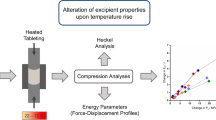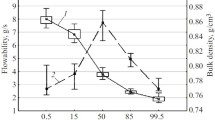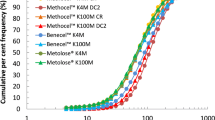Abstract
Purpose. The compression behaviour and the compactability of particles have been studied. In addition, an expression describing the bond strength over a tablet cross section was derived and these calculated values were compared with the experimentally determined tablet tensile strength values.
Methods. The compression behaviour of particles of a series of size fractions of four materials were assessed by tablet surface areas (particle fragmentation propensity) and by yield pressures (particle deformability), derived from in die Heckel profiles. The porosity and the tensile strength of the tablets were also determined.
Results. Sodium chloride and sodium bicarbonate possessed limited fragmentation while the converse applied for sucrose and lactose. Sodium chloride and sodium bicarbonate were the extreme materials with respect to particle deformability and compactability. Except for sodium chloride, a limited effect of original particle size on the compactability of the particles was observed.
Conclusions. The observations on the compactability of the powders was explained by postulating that fragmentation affects mainly the number of bonds in a compact cross section, while deformation affects mainly the bonding force of these bonds, through a relationship with the contact area between a pair of particles. The deviations between the predicted strength of particle-particle bonds and the determined tensile strength values was explained by a high bonding capacity of some particles, e.g. due to an unpredicted high surface deformability, or by a fracture mechanic effect during tablet strength determination.
Similar content being viewed by others
REFERENCES
C. Nyström, G. Alderborn, M. Duberg and P.G. Karehill. Bonding surface area and bonding mechanism — two important factors for the understanding of powder compactability. Drug. Dev. Ind. Pharm. 19: 2143–2196 (1993).
J.J. Benbow. Mechanisms of compaction. In Stanley-Wood, N.G. (Ed.), Enlargement and compaction of particulate solids., Butterworths, London, 1983, p. 169.
H. Vromans, A.H. de Boer, G.K. Bolhuis, C.F. Lerk, K.D. Kussendrager and H. Bosch. Studies on tableting properties of lactose. Part 2. Consolidation and compaction of different types of lactose. Pharm. Weekblad Sci. Ed. 7: 186–193 (1985).
A.H. de Boer, H. Vromans, C.F. Lerk, G.K. Bolhuis, K.D. Kussendrager and H. Bosch. Studies on tableting properties of lactose. Part III. The consolidation behaviour of sieve fractions of crystalline α-lactose monohydrate. Pharm. Weekblad Sci. Ed. 8: 145–150 (1986).
H. Leuenberger, J.D. Bonny, C.F. Lerk and H. Vromans. Relation between crushing strength and internal specific surface area of lactose compacts. Int. J. Pharm. 52: 91–100 (1989).
G. Alderborn, K. Pasanen and C. Nyström. Studies on direct compression of tablets. XI. Characterization of particle fragmentation during compaction by permeametry measurements of tablets. Int. J. Pharm. 23: 79–86 (1985).
J.T. Fell and J.M. Newton. Determination of tablet strength by the diametral compression test. J. Pharm. Sci. 59: 688–691 (1970).
G. Alderborn. Studies on direct compression of tablets. XV. An evaluation of the surface area obtained by permeametry measurements of tablets. Acta Pharm. Suec. 22: 177–184 (1985).
G. Alderborn and C. Nyström. Studies on direct compression of tablets. XIV. The effect of powder fineness on the relation between tablet permeametry surface area and compaction pressure. Powder Technol. 44: 37–42 (1985).
M. Eriksson and G. Alderborn. Mechanisms for post-compaction changes in tensile strength of sodium chloride compacts prepared from particles of different dimensions. Int. J. Pharm. 109: 59–72 (1994).
G. Alderborn and C. Nyström. Studies on direct compression of tablets. IV. The effect of particle size on the mechanical strength of tablets. Acta Pharm. Suec. 19: 381–390 (1982).
H. Rumpf. The strength of granules and agglomerates., In Knepper, W.A., Agglomeration, Interscience Publishers, New York, 1962, p. 379.
A.S. Rankell and T. Higuchi. Physics of tablet compression XV. Thermodynamic and kinetic aspects of adhesion under pressure. J. Pharm. Sci. 57: 574–577 (1968).
E.N. Hiestand. Dispersion forces and plastic deformation in tablet bond. J. Pharm. Sci. 74: 768–770 (1985).
M. Luangtana-anan and J.T. Fell. Bonding mechanisms in tabletting. Int. J. Pharm. 60: 197–202 (1990).
W.C. Duncan-Hewitt and G.C. Weatherly. Modeling the unaxial compaction of pharmaceutical powders using the mechanical properties of single crystals. I: Ductile materials. J. Pharm. Sci. 79: 147–152 (1990).
R.J. Roberts, R.C. Rowe and P. York. The relationship between indentation hardness of organic solids and their molecular structure. J. Mat. Sci. 29: 2289–2296 (1994).
M.J. Kontny, G.P. Grandolfi and G. Zografi. Water vapor sorption of water-soluble substances: studies of crystalline solids below their critical relative humidities. Pharm. Res. 4: 104–112 (1987).
A.A. Elamin, G. Alderborn and C. Ahlneck. Effect of precompaction storage conditions on the tablet strength of milled crystalline materials. Int. J. Pharm. 108: 213–224 (1994).
Author information
Authors and Affiliations
Rights and permissions
About this article
Cite this article
Eriksson, M., Alderborn, G. The Effect of Particle Fragmentation and Deformation on the Interparticulate Bond Formation Process During Powder Compaction. Pharm Res 12, 1031–1039 (1995). https://doi.org/10.1023/A:1016214616042
Issue Date:
DOI: https://doi.org/10.1023/A:1016214616042




